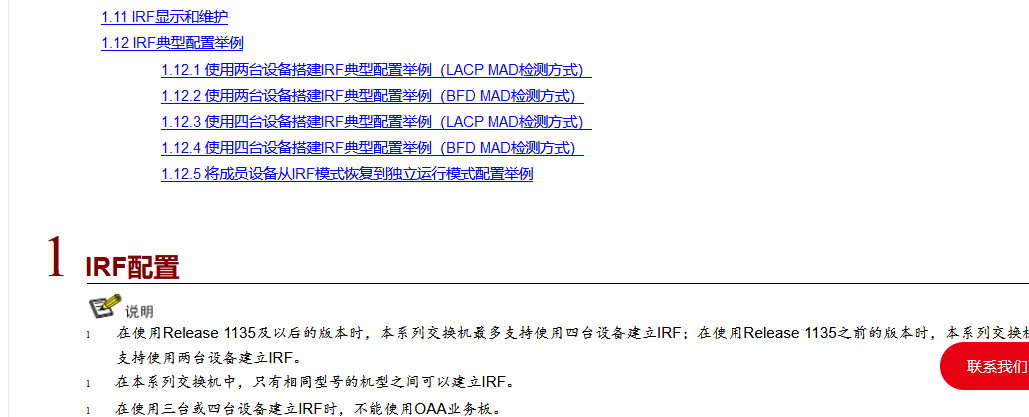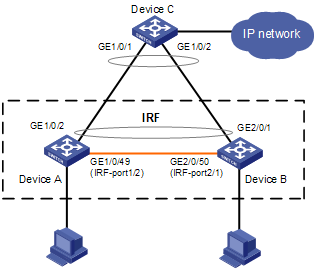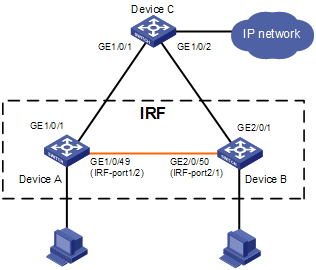华三s10508核心交换机堆叠配置命令是什么?
- 1关注
- 1收藏,3836浏览
问题描述:
s10508系列核心交换机堆叠配置命令是什么?怎么跟普通交换机堆叠配置命令不一致
- 2021-08-14提问
- 举报
-
(0)
最佳答案

http://www.h3c.com/cn/d_201203/741362_30005_0.htm#_Toc320277937
 <Sysname> system-view
<Sysname> system-view
[Sysname] irf member 1
Info: Member ID change will take effect after the switch reboots and operates in IRF mode.
[Sysname] interface ten-gigabitethernet 3/0/1
[Sysname-Ten-GigabitEthernet3/0/1] shutdown
[Sysname-Ten-GigabitEthernet3/0/1] quit
[Sysname] irf-port 2
[Sysname-irf-port2] port group interface ten-gigabitethernet 3/0/1
[Sysname-irf-port2] quit
[Sysname] interface ten-gigabitethernet 3/0/1
[Sysname-Ten-GigabitEthernet3/0/1] undo shutdown
[Sysname-Ten-GigabitEthernet3/0/1] quit
# 配置Device A的成员优先级为10,保证其在形成IRF后能够被选举为Master。
[DeviceA] irf priority 10
# 将当前配置保存到下次启动配置文件。
[Sysname] quit
<Sysname> save
# 将设备的运行模式切换到IRF模式。
<Sysname> system-view
[Sysname] chassis convert mode irf
- 2021-08-14回答
- 评论(0)
- 举报
-
(0)

以下是IRF的配置举例,请参考:
1.8 IRF典型配置举例
1.8.1 IRF典型配置举例(LACP MAD检测方式)
1. 组网需求
由于公司人员激增,接入层交换机提供的端口数目已经不能满足PC的接入需求。现需要在保护现有投资的基础上扩展端口接入数量,并要求网络易管理、易维护。
2. 组网图
图1-12 IRF典型配置组网图(LACP MAD检测方式)

3. 配置思路
· Device A提供的接入端口数目已经不能满足网络需求,需要另外增加一台设备Device B。(本文以两台设备组成IRF为例,在实际组网中可以根据需要,将多台设备组成IRF,配置思路和配置步骤与本例类似)
· 鉴于第二代智能弹性架构IRF技术具有管理简便、网络扩展能力强、可靠性高等优点,所以本例使用IRF技术构建接入层(即在Device A和Device B上配置IRF功能)。
· 为了防止万一IRF链路故障导致IRF分裂、网络中存在两个配置冲突的IRF,需要启用MAD检测功能。因为接入层设备较多,我们采用LACP MAD检测。
4. 配置步骤
![]()
为便于区分,下文配置中假设IRF形成前Device A的系统名称为DeviceA,Device B的系统名称为Device B;中间设备Device C的系统名称为DeviceC。
(1) 配置设备编号
# Device A保留缺省编号为1,不需要进行配置。
# 在Device B上将设备的成员编号修改为2。
<DeviceB> system-view
[DeviceB] irf member 1 renumber 2
Warning: Renumbering the switch number may result in configuration change or loss. Continue? [Y/N]:y
[DeviceB]
(2) 将两台设备断电后,按图1-12所示连接IRF链路,然后将两台设备上电。
# 在Device A上创建设备的IRF端口2,与物理端口GigabitEthernet1/0/49绑定,并保存配置。
<DeviceA> system-view
[DeviceA] interface gigabitethernet 1/0/49
[DeviceA-GigabitEthernet1/0/49] shutdown
[DeviceA] irf-port 1/2
[DeviceA-irf-port1/2] port group interface gigabitethernet 1/0/49
[DeviceA-irf-port1/2] quit
[DeviceA] interface gigabitethernet 1/0/49
[DeviceA-GigabitEthernet1/0/49] undo shutdown
[DeviceA-GigabitEthernet1/0/49] save
# 在Device B上创建设备的IRF端口1,与物理端口GigabitEthernet2/0/50绑定,并保存配置。
<DeviceB> system-view
[DeviceB] interface gigabitethernet 2/0/50
[DeviceB-GigabitEthernet2/0/50] shutdown
[DeviceB] irf-port 2/1
[DeviceB-irf-port2/1] port group interface gigabitethernet 2/0/50
[DeviceB-irf-port2/1] quit
[DeviceB] interface gigabitethernet 2/0/50
[DeviceB-GigabitEthernet2/0/50] undo shutdown
[DeviceB-GigabitEthernet2/0/50] save
# 激活DeviceA的IRF端口配置。
[DeviceA-GigabitEthernet1/0/49] quit
[DeviceA] irf-port-configuration active
# 激活DeviceB的IRF端口配置。
[DeviceB-GigabitEthernet2/0/50] quit
[DeviceB] irf-port-configuration active
(3) 两台设备间会进行Master竞选,竞选失败的一方将自动重启,重启完成后,IRF形成,系统名称统一为DeviceA。
(4) 配置LACP MAD检测
# 创建一个动态聚合端口,并使能LACP MAD检测功能。
<DeviceA> system-view
[DeviceA] interface bridge-aggregation 2
[DeviceA-Bridge-Aggregation2] link-aggregation mode dynamic
[DeviceA-Bridge-Aggregation2] mad enable
[DeviceA-Bridge-Aggregation2] quit
# 在聚合接口中添加成员端口GigabitEthernet1/0/1和GigabitEthernet2/0/1,专用于两台IRF成员设备与中间设备进行LACP MAD检测。
[DeviceA] interface gigabitethernet 1/0/1
[DeviceA-GigabitEthernet1/0/1] port link-aggregation group 2
[DeviceA-GigabitEthernet1/0/1] quit
[DeviceA] interface gigabitethernet 2/0/1
[DeviceA-GigabitEthernet2/0/1] port link-aggregation group 2
(5) 中间设备Device C的配置
Device C作为一台中间设备需要支持LACP功能,用来转发、处理LACP协议报文,协助Device A和Device B进行多Active检测。从节约成本的角度考虑,使用一台支持LACP功能的交换机即可。
# 创建一个动态聚合端口。
<DeviceC> system-view
[DeviceC] interface bridge-aggregation 2
[DeviceC-Bridge-Aggregation2] link-aggregation mode dynamic
[DeviceC-Bridge-Aggregation2] quit
# 在聚合端口中添加成员端口GigabitEthernet1/0/1和GigabitEthernet1/0/2,用于进行LACP MAD检测。
[DeviceC] interface gigabitethernet 1/0/1
[DeviceC-GigabitEthernet1/0/1] port link-aggregation group 2
[DeviceC-GigabitEthernet1/0/1] quit
[DeviceC] interface gigabitethernet 1/0/2
[DeviceC-GigabitEthernet1/0/2] port link-aggregation group 2
# 按图1-12所示连接LACP MAD链路。
1.8.2 IRF典型配置举例(ARP MAD检测方式)
1. 组网需求
由于网络规模迅速扩大,当前中心交换机(Device A)转发能力已经不能满足需求,现需要在保护现有投资的基础上将网络转发能力提高一倍,并要求网络易管理、易维护。
2. 组网图
图1-13 IRF典型配置组网图(ARP MAD检测方式)

3. 配置思路
· Device A处于局域网的汇聚层,为了将汇聚层的转发能力提高一倍,需要另外增加一台设备Device B。
· 鉴于第二代智能弹性架构IRF技术具有管理简便、网络扩展能力强、可靠性高等优点,所以本例使用IRF技术构建网络接入层(即在Device A和Device B上配置IRF功能),IRF通过双链路上行。
· 为了防止万一IRF链路故障导致IRF分裂、网络中存在两个配置冲突的IRF,需要启用MAD检测功能。因为成员设备比较少,我们采用ARP MAD检测方式来监测IRF的状态,复用链路上行传递ARP MAD报文。为防止环路发生,在IRF和Device C上启用MSTP功能。
4. 配置步骤
![]()
为便于区分,下文配置中假设IRF形成前Device A的系统名称为DeviceA,Device B的系统名称为Device B;中间设备Device C的系统名称为DeviceC。
(1) 配置设备编号
# Device A保留缺省编号为1,不需要进行配置。
# 在Device B上将设备的成员编号修改为2。
<DeviceB> system-view
[DeviceB] irf member 1 renumber 2
Warning: Renumbering the switch number may result in configuration change or loss. Continue? [Y/N]:y
[DeviceB]
(2) 将两台设备断电后,按图1-13所示连接IRF链路和ARP MAD检测链路,然后将两台设备上电。
# 在Device A上创建设备的IRF端口2,与物理端口GigabitEthernet1/0/49绑定,并保存配置。
<DeviceA> system-view
[DeviceA] interface gigabitethernet 1/0/49
[DeviceA-GigabitEthernet1/0/49] shutdown
[DeviceA] irf-port 1/2
[DeviceA-irf-port1/2] port group interface gigabitethernet 1/0/49
[DeviceA-irf-port1/2] quit
[DeviceA] interface gigabitethernet 1/0/49
[DeviceA-GigabitEthernet1/0/49] undo shutdown
[DeviceA-GigabitEthernet1/0/49] save
# 在Device B上创建设备的IRF端口1,与物理端口GigabitEthernet2/0/50绑定,并保存配置。
<DeviceB> system-view
[DeviceB] interface gigabitethernet 2/0/50
[DeviceB-GigabitEthernet2/0/50] shutdown
[DeviceB] irf-port 2/1
[DeviceB-irf-port2/1] port group interface gigabitethernet 2/0/50
[DeviceB-irf-port2/1] quit
[DeviceB] interface gigabitethernet 2/0/50
[DeviceB-GigabitEthernet2/0/50] undo shutdown
[DeviceB-GigabitEthernet2/0/50] save
# 激活DeviceA的IRF端口配置。
[DeviceA-GigabitEthernet1/0/49] quit
[DeviceA] irf-port-configuration active
# 激活DeviceB的IRF端口配置。
[DeviceB-GigabitEthernet2/0/50] quit
[DeviceB] irf-port-configuration active
(3) 两台设备间将会进行Master竞选,竞选失败的一方将自动重启,重启完成后,IRF形成,系统名称统一为DeviceA。
(4) 配置ARP MAD
# 在IRF上全局使能MSTP,以防止环路的发生。
<DeviceA> system-view
[DeviceA] stp enable
# 按图1-13所示连接ARP MAD检测链路。
# 将IRF配置为MAC地址立即改变。
[DeviceA] undo irf mac-address persistent
# 创建VLAN 3,并将Device A(成员编号为1)上的端口GigabitEthernet1/0/1和Device B(成员编号为2)上的端口GigabitEthernet2/0/1加入VLAN中。
[DeviceA] vlan 3
[DeviceA-vlan3] port gigabitethernet 1/0/1 gigabitethernet 2/0/1
[DeviceA-vlan3] quit
# 创建VLAN-interface3,并配置IP地址,使能ARP MAD检测功能。
[DeviceA] interface vlan-interface 3
[DeviceA-Vlan-interface3] ip address 192.168.2.1 24
[DeviceA-Vlan-interface3] mad arp enable
(5) 配置Device C
# 在全局使能MSTP,以防止环路的发生。
<DeviceC> system-view
[DeviceC] stp enable
# 创建VLAN 3,并将端口GigabitEthernet1/0/1和GigabitEthernet1/0/2加入VLAN 3中,用于转发ARP MAD报文。
[DeviceC] vlan 3
[DeviceC-vlan3] port gigabitethernet 1/0/1 gigabitethernet 1/0/2
[DeviceC-vlan3] quit
- 2021-08-14回答
- 评论(0)
- 举报
-
(0)
暂无评论
编辑答案


亲~登录后才可以操作哦!
确定你的邮箱还未认证,请认证邮箱或绑定手机后进行当前操作
举报
×
侵犯我的权益
×
侵犯了我企业的权益
×
- 1. 您举报的内容是什么?(请在邮件中列出您举报的内容和链接地址)
- 2. 您是谁?(身份证明材料,可以是身份证或护照等证件)
- 3. 是哪家企业?(营业执照,单位登记证明等证件)
- 4. 您与该企业的关系是?(您是企业法人或被授权人,需提供企业委托授权书)
抄袭了我的内容
×
原文链接或出处
诽谤我
×
- 1. 您举报的内容以及侵犯了您什么权益?(请在邮件中列出您举报的内容、链接地址,并给出简短的说明)
- 2. 您是谁?(身份证明材料,可以是身份证或护照等证件)
对根叔社区有害的内容
×
不规范转载
×
举报说明


暂无评论